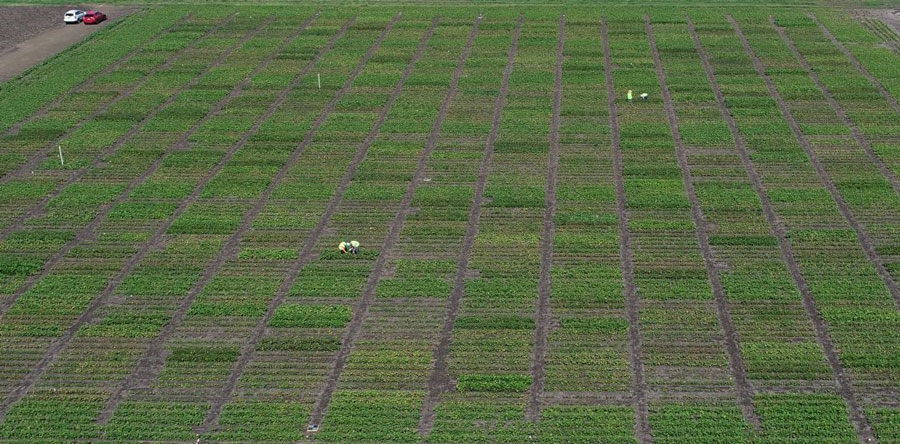Australia
March 13, 2023
.jpg)
The University of Queensland’s Millicent Smith, Shanice Van Haeften and Caitlin Dudley at one of the field trials. - Photo: Supplied
By flying unmanned aerial vehicles (UAVs) across their research paddocks in Allora and Gatton in Queensland’s Southern Downs, two PhD students are overcoming a significant mungbean breeding ‘bottleneck’.
Come rain or shine, Caitlin Dudley and Shanice Van Haeften have been examining whether UAVs can help to accelerate and support large-scale phenotyping in a mungbean breeding program.
That is, can the data collected via sensors mounted on UAVs help to characterise mungbean traits, especially key physiological traits that underpin yield?
Presenting the latest on their work at the recent GRDC-supported TropAg Conference in Brisbane, the University of Queensland PhD students said the short answer was yes.
UAV ‘traits’ can be used to determine important information such as how quickly the canopy develops. These traits can be further dissected through genetic analyses. In the future, this could lead to mungbeans with faster senescence behaviour, offering the chance to reduce desiccant use while improving harvesting practices.
Research history
Although mungbeans are well suited to the northern cropping system, Ms Dudley says there has been limited physiological and molecular research.
“To date, most research has focused on agronomic management, biotic stress and yield, resulting in constraints on crop productivity. There are still many physiological traits that are not ideal and yet to be explored, such as reproductive indeterminacy.”
Reproductive indeterminacy is the overlapping of vegetative growth, flowering and podding. It affects reproductive dynamics and canopy development – both important yield determinants – and has a management impact. Growers are unable to accurately predict when the crop reaches optimum flowering and have challenges with the timing of desiccation.
“You can assume that there would be compensation mechanisms in the plant when it is continually accumulating vegetative and reproductive components simultaneously,” Ms Dudley says.
She says this indeterminacy can create other difficulties. “It can make it hard to figure out when to spray, and with that increase regulations on the desiccants used. It can also make the crop vulnerable to stress.”
Although mungbean reproductive behaviour can be researched in the glasshouse, obtaining detailed measurements in the field is critical but much more difficult.
To address this phenotyping bottleneck, Ms Dudley and Ms Van Haeften planted a diverse set of mungbean germplasm from the National Mungbean Improvement Program at the Queensland Department of Agriculture and Fisheries’ sites in the Southern Downs.
 An image of a trial site taken with a UAV. PHOTO: Supplied
An image of a trial site taken with a UAV. PHOTO: Supplied
They then used UAVs to capture data on several traits linked to physiological mechanisms underpinning yield.
After flying the UAVs regularly across the research field sites, the images collected were stitched together into an orthomosaic, a complete and continuous image representation. A shape file, commonly used for geospatial analysis, was then created. And from that, the vegetative indices for each plot were extracted.
One of the traits captured, the optimised soil-adjusted vegetative index (OSAVI), was key.
Ms Van Haeften says the OSAVI trait shows variability in canopy density, sensitivity to soil brightness and vegetation cover. “It indicates greenness and there is a strong correlation with green biomass, crop yield and vigour.”
OSAVI values also helped map senescence – or crop ageing. “We looked at peak OSAVI, when it reached that peak and how OSAVI declined from the peak to physiological maturity, the typical harvest measure.
“What is really cool is that a UAV is able to detect the canopy dynamics in response to environmental conditions. Where we saw wet weather events, the canopy adapted to this by slowing down its canopy growth rate. It then shifted and went back to rapid accumulation.
“This is important information for physiologists, agronomists and breeders to improve their understanding of how mungbean responds, and recovers, to changes in its environment.”
Ms Van Haeften says that although the wet weather was not ideal and resulted in yield loss, it highlighted UAVs’ capability to characterise a crop’s growth over a season.
“This information could be exploited by growers in their own production systems by incorporating it into yield prediction models. Essentially, if we can track how extreme weather or disease impacts canopy growth, can we predict yield?”
Using UAV traits to understand canopy behaviour in a diverse population will allow Ms Dudley and Ms Van Haeften to understand the genetics underpinning them. This genetic information can be incorporated into the National Mungbean Improvement Program to improve mungbean productivity and sustainability. Establishing a UAV platform to capture key physiological traits is the first step. Ms Dudley and Ms Van Haeften are now dissecting the underlying genetic basis of flowering and senescence traits respectively.
Caitlin Dudley and Shanice Van Haeften work on GRDC-supported research via the Queensland Alliance for Agriculture and Food Innovation’s Centre for Crop Science at the University of Queensland.